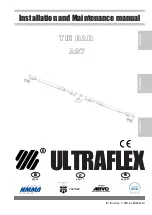
Page 14
Translation of the original operating manual
9.2 Aggressiveness adjustment
In addition to the depth, the aggressiveness of the tines relative to one another on the GK 400 M1
can also be changed. To do so, you only have to insert the pins for the harrow rows as desired in a
higher or lower hole. (Fig. 6)
Fig. 6
1: Aggressiveness adjustment
This makes it possible to adjust the 2 harrow rows with 12 (10) mm tines at different degrees of
aggressiveness. This also allows for compensation of various degrees of wear on the tines.
The two rows of tines tear open the sward and produce an optimal seedbed for the new grasses. If
the front row of tines should work more aggressively (e.g. under hard soil conditions), you must
place the pin in one of the top holes at the rear. In this way, the aggressiveness of two rows can
adjusted independently.
For this purpose, you can select one of seven levels. At an optimal forward speed, the tines make
an elliptical motion. The steeper the position of the tines, the smaller the motion. The flatter the
position of the tines, the larger the motion. If the sward is dense and intense tillage is required, the
tines should be positioned more steeply (see Fig. 6).
9.3 Levelling plate
The levelling plate eliminates molehills after the winter and
serve to roughly level the grassland. The height should be
adjusted so that it runs along the sward just above the
ground. It should not scratch into the sod. However, if the
sod is very uneven, allowing the levelling board to slightly
penetrate into the soil can improve the levelling effect on
the long term. To adjust the working height, remove the (4
pcs.) locking pins, crank the levelling plate to the desired
height, and fix it again with the 4 pins. (Fig. 7)
Fig. 7
TIP!
Remove the two pins on the right first, and then the two left pins, so that you can lift
the levelling plate more easily with the crank.













































